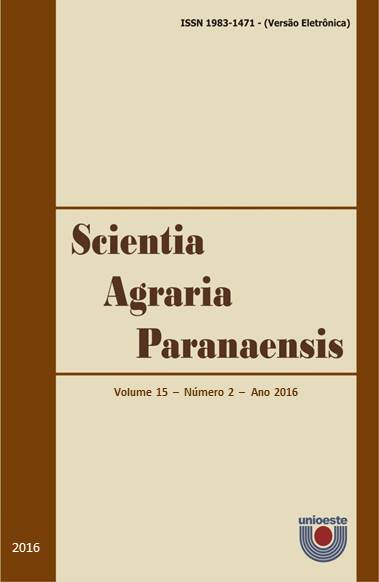Hypsometric relation for Pinus elliottii Engelm Engelm in different sociological positions at Dois Vizinhos, Paraná State
DOI:
https://doi.org/10.18188/sap.v15i2.11254Keywords:
competição, modelos hipsométricos, povoamentos florestaisAbstract
This study aims to model the hypsometric relation to Pinus elliottii Engelm in the city of Dois Vizinhos, Paraná State, Brazil, and to investigate the difference of the relationship between the different sociological positions. For this study was conducted a census on a plot of 0.25 ha located on the Campus of the Federal Technological University of Paraná, being measured diameter at breast height (dbh), total height (h) and sociological position of three strata: PS1 - dominant trees; PS2 - codominant trees; and PS3 - controlled or suppressed trees. Seven models of hypsometric relation determined by STEPWISE procedure were adjusted. The parameters used for selection of the models were the adjusted coefficient of determination (R2aj.), coefficient of variation (CV), calculated F value and the examination of residue. The analysis of covariance (ANACOVA) was used to verify the difference in level and trend of the equations selected among the different sociological positions. The model selected to describe the hypsometric relation was: ln h = 2.7654 to 15.62751 * 1 / √dap3 with R2aj. values equal to 0.53, CV 4.57% and F value equal to 331.47. Analysis of covariance indicated significant differences in level and slope model that describes the hypsometric relationship between the different sociological positions, fitting with this data again, generating equations for each sociological position, these being: PS1: ln h = 2.7905 to 15.6652 * 1 /√dap3; PS2: ln h = 2.6206 to 7.3158 * 1 /√dap3; and PS3: ln h = 2.7537 to 15.9753 * 1 /√dap3.
Downloads
Published
How to Cite
Issue
Section
License
Aviso de Direito Autoral Creative Commons
Política para Periódicos de Acesso Livre
Autores que publicam nesta revista concordam com os seguintes termos:
1. Autores mantém os direitos autorais e concedem à revista o direito de primeira publicação, com o trabalho simultaneamente licenciado sob a Licença Creative Commons Attribution que permite o compartilhamento do trabalho com reconhecimento da autoria e publicação inicial nesta revista.2. Autores têm autorização para assumir contratos adicionais separadamente, para distribuição não-exclusiva da versão do trabalho publicada nesta revista (ex.: publicar em repositório institucional ou como capítulo de livro), com reconhecimento de autoria e publicação inicial nesta revista.
3. Autores têm permissão e são estimulados a publicar e distribuir seu trabalho online (ex.: em repositórios institucionais ou na sua página pessoal) a qualquer ponto antes ou durante o processo editorial, já que isso pode gerar alterações produtivas, bem como aumentar o impacto e a citação do trabalho publicado (Veja O Efeito do Acesso Livre).
Licença Creative Commons
Esta obra está licenciada com uma Licença Creative Commons Atribuição-NãoComercial-CompartilhaIgual 4.0 Internacional, o que permite compartilhar, copiar, distribuir, exibir, reproduzir, a totalidade ou partes desde que não tenha objetivo comercial e sejam citados os autores e a fonte.


